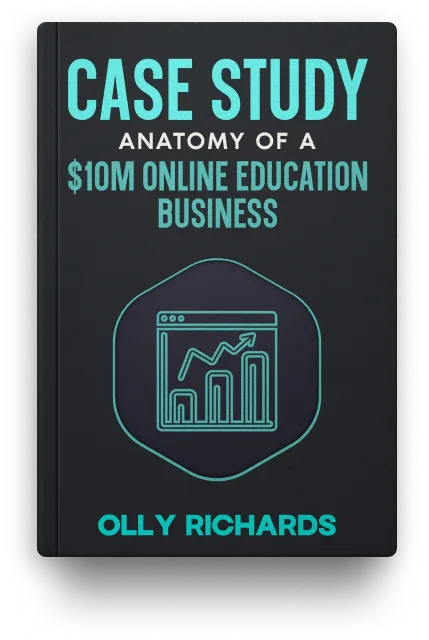A few years back, I invested 6-figures in a startup that I thought had great promise.
Not long after, the founders decided to pivot — same niche, entirely new business model.
I was against the move.
My rationale was simple:
What we’re doing is working. Better to stay focused and do the hard work.
(Nothing keeps businesses spinning their wheels more than chasing shiny objects.)
I was wrong.
Dead wrong, actually.
The pivot was a huge success, and the business went from doing 7-figures with margins thinner than a Rizla paper, to multiple seven figures with almost all profit.
Set to make everyone involved very wealthy indeed.
Boom.
Startup: 1. Olly: 0.
Now, consider this:
The founders were the same people…
Same skill set, same team.
The opportunity was different.
.
.
.
Next story…
When my business StoryLearning reached maturity in its existing business model a few years, I had this curious feeling of impotency.
I was “smarter” than I’d ever been…
More experienced…
Felt like I knew my s*** inside out and back to front…
Yet I wasn’t able to have a meaningful impact on the business anymore.
Why?
Because the business had reached what it was capable of without performing major surgery and making a major shift in the underlying business model.
Which I didn’t want to do.
So what did I do instead?
Rather than pivot the business (cos the business was great), I decided to employ my time in starting a new business – my business brand.
Total change in direction.
Not just a shift – a completely new niche, new business model. I even started my audience from scratch.
(There’s nothing better than starting a new business with a completely new audience… such a rush!)
Two years later?
This personal brand now does 7-figures in revenue, almost all profit.
In fact, I make more money from my personal brand than I do from the company I spent a decade building.
Mad, isn’t it?
Now, consider this:
I’m still the same dude.
Still doing my morning walks through the lanes of Hobbitshire. Still noodling on the piano or flying my Robin DR400. Still running my monthly dinners in London.
Same guy…
Same knowledge…
New opportunity.
.
.
.
This creates a bit of a dilemma.
See, I do believe that the best businesses are built slowly, over time.
- Step 1: Get something working (the hardest thing)
- Step 2: Get it to work better (the long, tedious part)
- Step 3: Keep going and don’t stop (the profitable part)
This is how I built StoryLearning.
And so I’ve had a bias towards telling entrepreneurs who are struggling:
“Look, it’s supposed to be hard, so just keep at it. Work on yourself. Work on the business.”
But I’ve also seen first-hand how pivoting can indeed be the best decision — by a country mile.
And the truth is, I think it’s very, very difficult to know when the right time to pivot is.
I think the answer can only lie in assessing the opportunities and going after the one that most excites you.
For example, if your business is working great, and you see a clear path to growing it further, then you should probably stick to that. (That’s what I did with StoryLearning for 10 years.)
But if your business is stagnant, you don’t see a clear path to growing it, AND you see a bigger opportunity elsewhere (related or not), you should probably go for it. (That’s what happened in the examples from this email.)
Now here’s the key…
If you decide to pivot to a “big, beautiful” opportunity, then pivot hard.
You can’t do it by halves.
Just this week, in three separate conversations with entrepreneurs who are thinking of pivoting I heard the following:
> “What about all this stuff I’ve already got?”
> “What about my existing business?”
> “What about the membership I built?”
In each case, my answer was blunt:
Ruthlessly cut it.
Leave it behind.
Not because what you were doing before wasn’t good…
Not because you couldn’t grow it if you wanted to…
But because your skill set – the person you are – applied to a new opportunity?
That’s going to have a wildly different outcome.
It could change your entire life.
And fast.
This is crystal clear to me now.
Everyone reading this is smart as hell. Perfectly capable of running a 6- or 7-figure business. Capable of turning their life into anything they want.
It’s the vehicle you choose to attach yourself to that determines everything.
Your business model is like choosing between a bicycle and a Ferrari.
Same driver.
Same destination.
Completely different journey.
I watch entrepreneurs cling to their bicycles, pedalling furiously, wondering why they’re not getting anywhere fast.
Meanwhile, the Ferrari is sitting right there.
Keys in the ignition.
(Sidenote — I’ve always wanted a midnight blue Ferarri Portofino. I think they’re gorgeous cars. Problem is, where I live in Hobbitshire, there are so many potholes that I’m not convinced I’d even manage to get it out of the village without snapping the bumper clean off. Oh, and you can’t fit the weekly shopping in the boot. Or take any passengers. Or drive it to Tescos because someone will key it or deliberately slam their car door hard into the side. But if it wasn’t for all those things, I’d be really tempted.)
Look, I get it…
Letting go is terrifying.
But if you’re holding on to a past version of your business…
If you’re struggling to let go…
Just remember fortune favours the brave.
There’s something amazing waiting for you on the other side.
And if it doesn’t work?
Well, you can always go back to what you were doing before.
(Or come and help me fill in some potholes — I’d pay good money for someone to do that.)
The same person who built what you have now is capable of building something ten times better.
You just need to give yourself permission to try.
Namaste,
Olly

